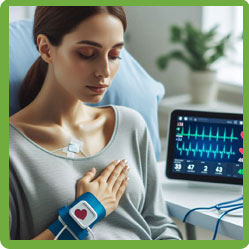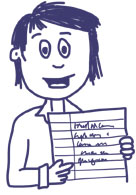
The Lungs & Heart
The lungs and heart are vital organs in the circulatory and respiratory systems. In this topic, you’ll learn how the lungs carry out gas exchange (taking in oxygen and removing carbon dioxide), and how the heart pumps blood around the body. This section covers the structure, function, and importance of these organs in supplying cells with oxygen and nutrients.
The Respiratory System and the Lungs
The respiratory system is responsible for breathing and gas exchange. Air enters through the nose or mouth, travels down the trachea, then through the bronchi and bronchioles, and finally reaches tiny air sacs called alveoli in the lungs.
The lungs are specially adapted for exchanging gases between the air and the bloodstream. This process is essential for getting oxygen into the body and removing carbon dioxide.
Ventilation – Breathing In and Out
Ventilation is the process of moving air in and out of the lungs:
- When you inhale, the intercostal muscles and diaphragm contract, increasing chest volume and pulling air in.
- When you exhale, these muscles relax, decreasing chest volume and pushing air out.
This movement keeps fresh air flowing into the alveoli, where gas exchange happens.
Revision Notes

The Cornell method is like a supercharged note-taking system that helps you ace your revision!
Print out our blank revision notes pages to help you revise.
How to make effective revision notes with the Cornell method.
Exam Questions & Answers

Download and print off practice our FREE worksheet with exam style questions on Cell Biology.
Gas Exchange and the Alveoli
Gas exchange takes place in the alveoli – tiny, balloon-like air sacs in the lungs. They are surrounded by a network of capillaries, allowing oxygen to diffuse into the blood and carbon dioxide to diffuse out into the lungs.
Alveoli are adapted for efficient gas exchange:
- Large surface area
- Thin walls (1 cell thick)
- Moist lining
- Rich blood supply
The Circulatory System
The circulatory system transports oxygen, nutrients, and waste products around the body. It includes:
- The heart – a muscular organ that pumps blood
- Blood vessels – tubes that carry blood
- Blood – the transport fluid
It is a double circulatory system:
- The right side pumps deoxygenated blood to the lungs
- The left side pumps oxygenated blood to the body
Blood Vessels
There are three main types of blood vessels:
- Arteries – carry blood away from the heart at high pressure
- Veins – carry blood toward the heart at low pressure and have valves
- Capillaries – tiny vessels where substances like oxygen and glucose are exchanged between the blood and cells
Blood and White Blood Cells
Blood is made up of several components:
- Red blood cells – carry oxygen using haemoglobin
- White blood cells – part of the immune system, they fight infection
- Platelets – help with clotting
- Plasma – the liquid that carries everything
White blood cells defend the body by:
- Engulfing pathogens (phagocytosis)
- Producing antibodies to destroy specific microbes
- Producing antitoxins to neutralise harmful toxins
Also see Non-Communicable Diseases, Respiration, Cell Biology
Links for Learning
Bitesize: The Heart.
Bitesize: Blood.
Bitesize: Circulation.
Bitesize: The Circulatory System.
Revision Notes

The Cornell method is like a supercharged note-taking system that helps you ace your revision!
Print out our blank revision notes pages to help you revise.
How to make effective revision notes with the Cornell method.


